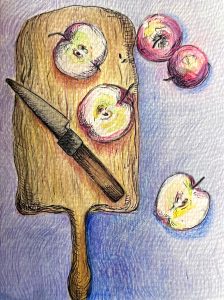When I walk to work every day, I greet two security guards, walk over a moat, hold my ID card to a sensor that makes the door click open in a satisfyingly sci-fi way, and I walk into the relief of air conditioning from the 90°F plus heat. I’m in a city of 12 million people, it’s summer in January, and yes, I said a moat. Needless to say, the experience of walking into the plant systematics lab at the University of Sao Paulo (USP) is quite different from that at UW Biology.
In a way, it feels like I work in a medieval fortress filled with 21st century science. Step inside after crossing the moat, and you will find towering metal cabinets filled with dried plant collections, hear the whir of -80°C freezers, and see labs adorned with the latest in scientific equipment. The students here say we work “above the waves,” since our building literally sits on top of a small artificial lake. While it doesn’t make a whole lot of sense for housing the herbarium and labs (moisture and humidity are seen as the enemy in these settings), it’s nonetheless a truly unique and functional place to work.

Surrounded by water and lush greenery, the plant systematics lab at the University of Sao Paulo is a kind of oasis in the middle of the concrete jungle of Sao Paulo.

Instead of being patrolled by vicious crocodiles, our moat is filled with koi and turtles, and while they provide very little protection against marauders, they prevent mosquitos from breeding and add a little happiness to your day.
I moved to Sao Paulo, Brazil almost exactly three months ago to study the evolutionary relationships of the plant family Bignoniaceae with Lucia Lohmann’s group at USP. My advisor at UW, Richard Olmstead, has been collaborating with Dr. Lohmann to study this plant group for almost a decade. The Bignoniaceae is a mainly tropical family containing over 800 species. Some familiar members of this family, characterized by showy trumpet-shaped flowers, may include North American natives Catalpa, Campsis, Bignonia, and Chilopsis. The section of the family I’m working on, the tribe Jacarandeae, is limited to the New World tropics and contains about 50 species. Since I’ve been in Brazil, I’ve had the chance to see these plants in their native range in the northern states of Bahia and Para.
So why on earth would anyone move 7000 miles away from home to study plants when there are perfectly interesting plants in Seattle? Well, the New World tropics harbor nearly 37% of the world’s plant species, making it the most species rich region on Earth. Therefore, it is a very exciting place to study the processes and patterns generating plant diversity. But what are these processes and patterns, and how and in what combinations did they give rise to this incredibly diverse plant assemblage? Explorers and scientists alike have pondered this question for a very long time. Through my work on this family of plants, I hope to help answer part of this big question.
In order to do this, the first goal of my work is to generate a phylogeny, or tree-like evolutionary history, of the Jacarandeae using information stored in DNA sequences of each species in the group. To generate this phylogeny, I am extracting DNA from tissue of each species, amplifying gene regions of interest using a process called polymerase chain reaction (PCR), and then sequencing the resulting amplified DNA. Once I have sequences from many gene regions, I will feed them into computational statistical programs that use differences between these sequences to determine how the plants they came from are related to one another, ultimately spitting out a phylogenetic tree. Eventually, I also plan to gather and combine data from both the Olmstead and Lohmann labs to generate a phylogenic tree for the entire Bignoniaceae. These phylogenetic trees will be incredibly valuable because I can use them as tools to better understand how these plant groups have diversified through space and time across the New World tropics.
An additional source of motivation for my work is the high amount of habitat loss occurring in Brazil. When I had the opportunity to see my plants in the field, I noticed that many locations where my plants had been collected in the not so distant past had been plowed over and built upon. In Amazonia, there were times when the only landscape you could see were farms and cattle ranches. Seeing this destruction has given me the drive to work harder to unlock the evolutionary stories held in my plants’ genetic codes before they’re gone for good.
In closing, studying these plants isn’t just important in terms of understanding a key phenomenon that has perplexed scientists for eons, but also in terms of cataloging the diversity of threatened ecosystems before they fall victim to habitat destruction. I hope my remaining three months working above the waves in Sao Paulo will help me to accomplish a little bit of both.
~Audrey





